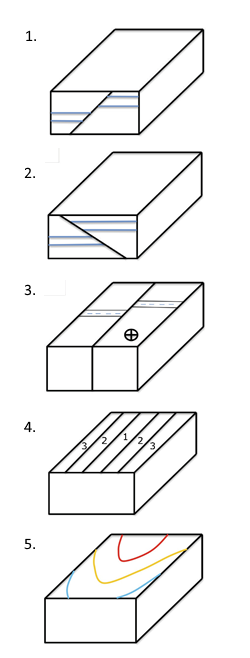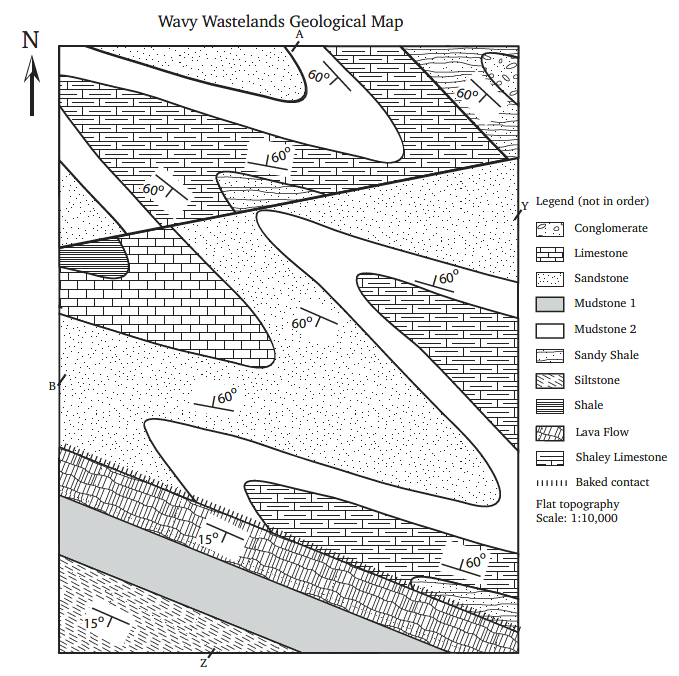Chapter 8. Geological Structures
Exercises on Geological Structures Part 2: Folds, Faults, and Unconformities
Adapted by Karla Panchuk, Joyce M. McBeth, & Lyndsay R. Hauber (2018) University of Saskatchewan from Deline B, Harris R & Tefend K. (2015) “Laboratory Manual for Introductory Geology”. First Edition. Chapter 12 “Crustal Deformation” by Randa Harris and Bradley Deline, CC BY-SA 4.0. View source. Last edited: 18 Oct 2020
In Part 2 of geological structures, students will learn how to interpret more complex geological structures generated by folding and faulting.
Name: _______________
NSID and student number: ____________
Date and lab section time: _____________
TAs’ names: _______________ _______________
Please hand in this lab to your TAs at the end of the lab period.
This lab will take the full amount of lab time to complete. This lab and the second geological structures lab will be on the lab final and students often struggle with this material. Read the lab and overview section online in advance so you can make best use of your time in lab.
8-E3 EXERCISE – GOOGLE EARTH
This exercise is part of your grade for this lab. Open Google Earth or Google Maps and navigate to the location 75°50’18.91″N 101°18’55.83″W. This is a view of part of Bathurst Island, Nunavut, Canada. If you are using Google Maps ensure you have satellite data turned on. Zoom out to about 75 km altitude (45 miles). Note that the landscape is fairly flat in this region, there is only about 400 m of relief (elevations are between 0 m and 400 m). Refer to the figure below (Figure 8-E7) along with Google Earth or Google Maps to answer the following questions.

Source: Joyce M. McBeth (2018) CC BY 4.0, Satellite image from © 2018 Google Earth, Data: Landsat/Copernicus. Geologic map prepared by J. M. McBeth based on information from Harrison et al (2014) Canadian Geoscience Map 32 (preliminary), Geological Survey of Canada, view source.
- (2 pts) Describe the patterns formed by the layers of rock exposed in this image. What do these patterns tell you about the geologic structure(s) formed by the rocks in this area?
- (1 pt) Note the relative ages of the rocks presented in Figure 8-E7. Given this information, what kind of structure do you think is found in the red boxed area of the satellite image?
- (2 pts) Sketch a rough cross-section of your interpretation of the geology in Figure 8-E7, between points X and Y (X-Y).
- (1 pt) Is there data missing from the map that would help you improve the accuracy of your interpretation? If so, what data would help you to understand the geology better?
8-E4 EXERCISES – BLOCK DIAGRAMS
Practice exercises: your TA will walk you through this exercise to help you learn how to interpret block diagrams. Fill in the missing information on the block diagrams below. A key is provided at the end of this lab document for you to check your work. For each diagram, draw in the geological contacts on each side of the block. Add strike and dip symbols, and other symbols to document geologic features (like direction of movement on faults). Also write the name of the geological feature next to each diagram. Presume that the geologic units have not been overturned (i.e., they are not flipped upside down). Note: the blue lines at the top of block #3 represent a road. Blocks #4 and #5 have more than one correct answer – can you see both possibilities?
The rest of the exercises in this lab will be part of your grade for this lab.
1. (4 pts each, 24 pts total) Please complete the following block diagrams. For each block diagram:
- Complete the diagram drawing in the geological contacts on each side of the block
- Add symbols indicating the strike and dip of each geological layer as well as symbols documenting any other geological features (include the direction of movement for any faults)
- In the space provided under the block diagram write the specific name of the geological feature
- Please note that relative ages of the layers are provided for diagrams 4 and 5 (1 is the oldest, 6 is the youngest)
- Presume that the geologic units have not been overturned for any of the exercises in this lab (i.e., they are not flipped upside down).
- The black line at the top of block #2 is a fault line
8-E5 EXERCISES – COMPLEX GEOLOGICAL MAPS & CROSS-SECTIONS
The following geological map exercise will give you practice with constructing geological cross-sections for more complex mapping areas. The mapping area in this exercise is flat; there is no topography (and thus no contour lines). Note: you will need to hand in your map along with the cross-sections you prepare in this exercise.
Map: Wavy Wastelands
- (2 pts) Examine the map of the Wavy Wastelands. Refer to the map legend. Note that the rock types are not presented in order of age in the legend – this is one of the things you will determine in this lab. What kind of rocks are found in this map area: sedimentary, igneous, and/or metamorphic? How many units can you see?
- (2 pts) Note the strike and dip symbol on the map. Which direction are the units striking and dipping? Do the strike and dip of the beds change at all as you move across the map area?
- (2 pts) There is a major unconformity in the map area: what kind of unconformity is it? Outline the trace of the unconformity in red on your map.
- (12 pts) Draw fold axial traces on the map for the folds in the map area (there should be six). Indicate whether the folds are anticlines or synclines by putting the appropriate symbols on the map for each fold. Note that all the folds are plunging in the same direction.
- (7 pts) Make a list of formations from oldest to youngest. Which geologic laws/principles did you use to prepare your list?
- (1 pt) There is a fault in the map area. Which side of the fault is upthrown relative to the other side? Mark this on your map.
- (1 pt) The fault plane for this normal fault dips in which direction? ___________
- (2 pts) Note the scale of the map. What is the distance in metres between point Y and point Z? What is the distance in metres between point A and point B?
- (15 pts) Prepare a cross-section through the map from position Y to Z (Y-Z).
- (15 pts) Prepare a cross-section through the map from position A to B (A-B).
- (7 pts) In point form, describe the geological history of the map area.





